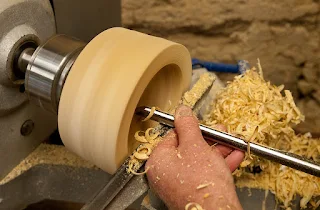Lathe and Wood Working :
A Look at Anglo-Saxon and Viking Techniques
Wood was a precious resource for the Anglo-Saxons and Vikings.
These medieval carpenters were skilled at selecting the right timber for the job, even using natural junctions where a branch joined to the tree for stronger joints. They would also "follow the grain" to ensure the finished product was as strong as possible.
Most of the woodworking during this time was done "green," meaning the timber was not seasoned before working.
This made it easier to split and less likely to crack as it dried. Axes and adzes were used for shaping, but saws were expensive and difficult to maintain, with only 13 recorded in the kingdom in 1086.
Wood was used for everything from buildings and ships to everyday items like cups, bowls, spoons, and plates.
Carpentry skills were employed by fishermen, weavers, and even shopkeepers and traders. The pole lathe was used to shape cups and bowls, with power created by pumping the treadle down and letting the pole rotate it back up.
Whetstones were necessary for sharpening tools, and much of the woodworking was ornately carved and painted.
Basket weaving was also a common skill, using thin strips of wood and bark, fine branches, and even grasses.
While large scale timber production had yet to make a significant impact, the Vikings are regarded as "environmental terrorists" in Iceland due to their eventual felling of all the trees on the island.
It's difficult to imagine much from this time that wasn't made of wood.
Tags
Articles
Wood lathe techniques
wood turning works
woodturning for beginners
woodturning lessons
